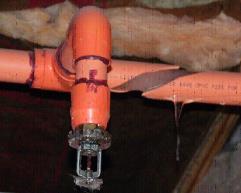Winter Freeze Precautions
Posted November 07, 2014

In “deep-freeze” conditions, a broken window or an open door in an un-insulated or unheated area can let in enough cold to freeze nearby piping and start a catastrophic chain of events. Any equipment that contains or uses water, produces condensate, or depends on pneumatic controls is vulnerable to freezing. Other conditions that make your business susceptible to freeze-ups are heating systems that lack reserve capacity beyond their normal heating load, poor building insulation, and piping run out of doors.
The following guidelines will help you plan for and implement preventive measures to better protect your business from the threat of freeze-ups.
Before the Cold Sets In
If at all possible, implement these measures in the fall, before the onset of cold weather.
1. Update your Emergency Response Program for winter emergencies to include appropriate response procedures for deep-freeze conditions.
- Appoint one or more members of the Emergency Response Team to monitor weather forecasts and initiate winter emergency procedures when appropriate.
- Develop procedures and priorities to be implemented when you lose heat and/or electricity.
2. Determine which processes are dependent upon continued building heat or electricity for safety (i.e., processes that are subject to solidification or runaway reactions) and need prompt attention.
3. Identify equipment, processes, and piping that contains or uses water or other liquid subject to freezing; they will need to be promptly and thoroughly drained if heat or electricity is lost.
4. Identify building areas that are unusually difficult to heat or that lose heat rapidly. Install ordinary thermometers to allow temperature monitoring during cold spells.
5. Identify equipment that is vulnerable to freezing. Prepare the equipment for cold weather by:
- Draining and securing any idle equipment,
- Draining condensate frequently,
- Providing adequate heat or locating the equipment in a heated enclosure, and/or
- Protecting it with suitable anti-freeze.
6. Service heating system before the heating season begins. Make sure adequate supplies of alternate fuels are on hand if the system is capable of dual firing.
7. Inspect and maintain the building shell to minimize unnecessary openings. Fix windows and doors so they close tightly. Caulk, insulate, and weather-strip as needed. Close and seal unneeded dampers, louvers and vents.
8. Drain condensate from dry-pipe sprinkler system piping by opening the priming water level drain valve until the water in the riser has been expelled and by using the auxiliary drains installed at system low points. If there are any trapped sections of branch line piping, it may be necessary to remove sprinklers and drain the water into a bucket.
9. Open any on-site fire hydrants and allow water to flow until it is flowing clear. This measure flushes any debris from the underground main and exercises the hydrant valve. Then slowly close the hydrant, making sure that it drains. Water can often be heard draining from the hydrant and you will notice suction if you place a hand over the hydrant hose connection as the drainage occurs.
During Cold Spells
- Monitor temperatures every few hours in vulnerable areas.
- Provide safe, portable heaters for vulnerable areas that might fall below 40 degrees.
- Provide heat or steam tracing for exterior piping that either contains liquids or needs to maintain constant temperatures.
- Use tarps to erect temporary windbreaks. For a permanent windbreak, consider planting evergreen trees and hedges upwind (prevailing winter wind directions) of vulnerable buildings and equipment.
Content Provided by CNA Insurance Company
The information, examples and suggestions presented in this material have been developed from sources believed to be reliable, but they should not be construed as legal or other professional advice. CNA accepts no responsibility for the accuracy or completeness of this material and recommends the consultation with competent legal counsel and/or other professional advisors before applying this material in any particular factual situations. This material is for illustrative purposes and is not intended to constitute a contract. Please remember that only the relevant insurance policy can provide the actual terms, coverages, amounts, conditions and exclusions for an insured. All products and services may not be available in all states and may be subject to change without notice. CNA is a registered trademark of CNA Financial Corporation. Copyright © 2007 CNA. All rights reserved.
CLICK BELOW FOR THE FULL RISK CONTROL DOCUMENT FROM CNA INSURANCE COMPANY:
